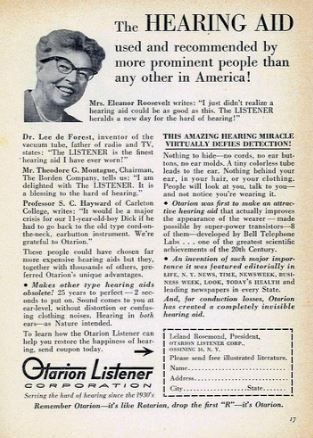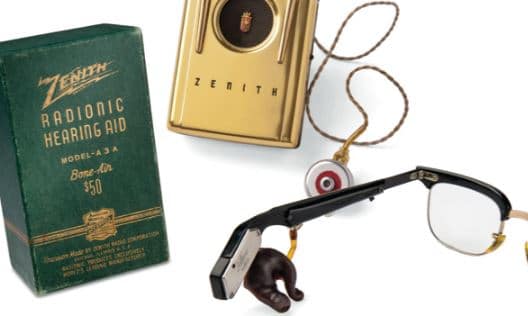Editor’s Note: Today’s post continues a discussion on the evolution of hearing aid technology by Abigail Farmer and Bruno Sarda.
The Transistor (Modern) Era
The next generation of hearing aids quickly adopted the new transistor technology that Bell Laboratories had introduced in 1948. The first transistor hearing aid was introduced by Sonotone in 1952. Early transistors had many issues, many of which were uncovered and worked out in the hearing aid market. In addition, the transistor required greater operating voltage, and the need to solve this problem without compromising size and weight was a key contributor to the development of the silver-oxide hearing cell.1
Since 1953, transistors have been the key technology underpinning hearing aids. This was accelerated by the fact that AT&T offered royalty-free licensing of transistor technology to anyone working on hearing aids.2 Raytheon, whose dominant technology at the time was still vacuum tubes, invested in a transistor development program and decided to hire exclusively hearing impaired workers, all of whom wore experimental transistorized hearing aids.3 These various moves had immediate effect, as evidenced by the fact that in 1953 over 200,000 transistorized hearing aids were sold, most of which made with Raytheon technology.4
Hearing aids wearability was greatly helped by advances in miniaturization, with great leaps made during WWII and after due to military investments, including the integrated circuit in the late 50’s, whose first commercial application was in hearing aids.5 In a 1965 article in Electronics, Intel founder Gordon Moore dated the start of the miniaturization movement to the introduction of integrated circuits (IC) in the 1950’s.6 These are credited with enabling substantial miniaturization of hearing aids.7 However, according to Thomas Misa, military interest in miniaturized electronics began with the walkie-talkie in the late 1930s.8 In 1961, Senn and Riehs of the US Army confirmed that “the philosophy of miniaturization” became prominent during WWII when subminiature vacuum tubes started being used for a variety of devices.9
However, the fact that hearing aids were now small enough to be worn on the body led to an unexpected discovery that itself led to new science and technology development. The humidity from the wearer’s body was causing transistors to fail in a matter of weeks, due to germanium’s inability to withstand heat and moisture. The military also had concerns about the reliability of germanium for missile electronics.10
As a result, Texas Instrument (TI) introduced a silicon transistor in 1954, which quickly caused Raytheon to lose its status as the world’s leading manufacturer of transistors.11 TI had only entered the semiconductor market two years prior with a focus on military and telecom applications, however, they used the hearing aid market to refine their mass-production techniques and the hearing aid industry to test the quality of their products.12

1957 Otarion Listener Hearing Aid Ad, Featuring Eleanor Roosevelt.
Just four years later, Jack Kilby, an electrical engineer at TI, developed what would become the first integrated circuit (he would later be awarded the Nobel Prize in Physics in 2000) once enhanced by his then-colleague, Robert Noyce, who left TI in 1958 to co-found Fairchild Semiconductor (and would later co-found Intel with Andrew Grove).13
Due to continued miniaturization of components, the first one-piece hearing aid that could be worn at the ear, the Otarion Listener, was introduced in 1957. Lee DeForest, vacuum tube innovator in the early 1900’s, now needed a hearing aid himself and became a spokesperson for Otarion.14
Most of the hearing aid innovation that occurred in the following decades could be described as incremental, although the hearing industry participated in some significant technological transformations along the way, most notably the move from analog to digital.
The first step toward a digital hearing aid was taken when magnetic microphones were replaced by ceramic in 1967, but it was not until 1983 that Auditone introduced the first wearable digital hearing aid.15 In 1988, the Knowles amplifier allowed a further size reduction that enabled the first hearing aid small enough to be worn inside the ear canal.16
In 1996, the first hearing aid that incorporated digital signal processing technology (DSP) was introduced. By 2005, 93% of hearing aids sold in the US contained DSP technology.17
DSP is a form of computer science that uses signals (i.e., sound waves or images) as input, and applies algorithms to analyze and interpret these signals after they’ve been converted into digital form.
DSP originated in the 1960’s as digital computers first started appearing, though it is no surprise that initial applications were for military uses such as radar, sonar and secure communications. The first non-Defense government use was by NASA for space exploration, and the first commercial uses were in oil exploration.18 DSP was a radical step improvement in hearing aid technology but as Edwards argues “could have been predicted by those who were aware of DSP use in non-hearing aid fields.”19
Stay tuned for Part 5: RIC Hearing Aids and Other Innovations
- Id.
- G.E. Moore, Cramming More Components onto Integrated Circuits, 38 Electronics, Apr. 1965, at 1.
- Staab, Hearing Aid Technology Evolution, supra note 20.
- Thomas J. Misa, Military Needs, Commercial Realities and the Development of the Transistor, 1948–1958, inMilitary Enterprise and Technological Change: Perspectives on the American Experience 253–87 (Merritt Roe Smith, ed. 1985); see alsoC. Lécuyer, Making Silicon Valley: Innovation and the Growth of High Tech, 1930-1970 (2005).
- G. Senn and R. Riehs, Miniaturization in Communications Equipment, inMiniaturization 94 (H. Gilbert, ed., 1961).
- The Transistor, 55 Volta Rev., Jun. 1953, at 308.
- Mills, supra note 16.
- Id.
- Staab, Hearing Aid Technology Evolution, supra note 20.
- No Royalty Payments on Transistors in Hearing Aids, Talk: News and Information about Your Telephone Service, Sept. 1954, at 86-050, box 11, binder, William Shockley Papers, Stanford Archives.
- George Rostky, Hearing with Transistors, in The Transistor, A Biography, at 13 (1997).
- Mills, supra note 16.
- Wayne Staab, Hearing Aid Technology Evolution, supra note 20.
- Id.
- Sandlin, supra note 31, at 21-31
- Id.
- Brent Edwards, The Future of Hearing Aid Technology, 11 Trends in Amplification, Mar. 2007, at 31-45.
- Steven Smith, The Scientist and Engineer’s Guide to Digital Signal Processing 1–10 (1997).
- Id.
*featured image courtesy northwestern

Abigail Farmer graduated summa cum laude with B.A.s in French and Spanish from Texas A&M University. Before starting law school, she interned with the U.S. Commercial Service in Paris, France. Abigail served as Executive Note and Comment Editor for the Arizona State Law Journal from 2014–2015 and as the Hong Kong team editor for the Wilhem C. Vis International Commercial Arbitration Moot from 2015–2016. She also co-authored an article on bitcoins and estate planning, which won the Mary Moers Wenig Student Writing Competition and was published in the ACTEC Law Journal; she and her co-author presented the article at the Arizona State Bar Convention. Abigail is graduating summa cum laude with a J.D. from the Sandra Day O’Connor College of Law and with an M.B.A. from the W.P. Carey School of Business. After graduation, Abigail will join Shell’s legal department in Houston, Texas
 Bruno Sarda is a leading practitioner in the field of corporate sustainability at Dell, where he’s worked since 2005. In his role as Director of Social Responsibility, he leads the company’s strategy on social aspects of sustainability, including human rights and labor practices, working with internal and external stakeholders. He also manages Dell’s groundbreaking partnership with Phoenix-based TGen (Translational Genomics Research Institute) to accelerate adoption of precision medicine in addressing childhood cancer. In addition, Sarda is an adjunct faculty member and Senior Sustainability Scholar at Arizona State University, where he teaches and helped design and launch the Executive Master’s for Sustainability Leadership working with the Rob and Melani Walton Sustainability Solutions Initiatives at ASU.
Bruno Sarda is a leading practitioner in the field of corporate sustainability at Dell, where he’s worked since 2005. In his role as Director of Social Responsibility, he leads the company’s strategy on social aspects of sustainability, including human rights and labor practices, working with internal and external stakeholders. He also manages Dell’s groundbreaking partnership with Phoenix-based TGen (Translational Genomics Research Institute) to accelerate adoption of precision medicine in addressing childhood cancer. In addition, Sarda is an adjunct faculty member and Senior Sustainability Scholar at Arizona State University, where he teaches and helped design and launch the Executive Master’s for Sustainability Leadership working with the Rob and Melani Walton Sustainability Solutions Initiatives at ASU.








I am enjoying this series of articles and maybe should wait on the last part before commenting. However I can’t resist asking how the miniaturization of hearing aids can be discussed without reference to Hugh Knowles’ transducer work. It took more than transistors to make miniature hearing aids possible.
Thanks for the additional perspective. We did not come across Hugh Knowles in our research; however, the purpose of the paper was to provide a high-level analysis of all the different forces at play in hearing aid development (beyond technological advances), so including everything wasn’t feasible.